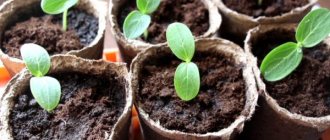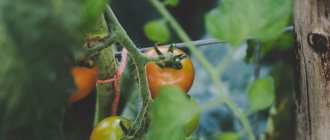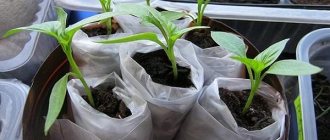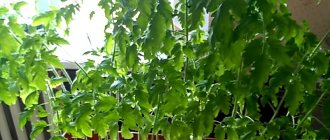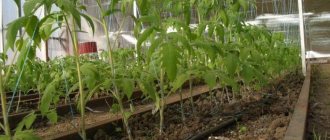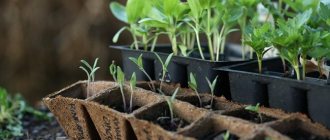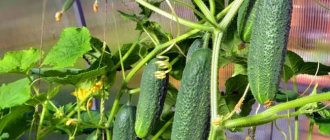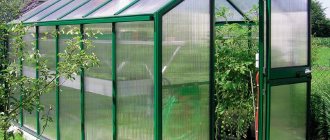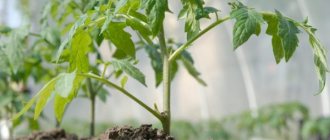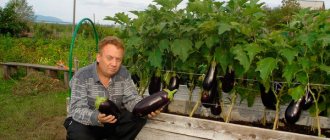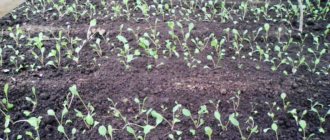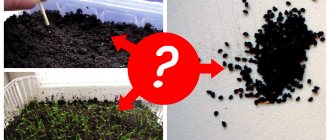The correct temperature regime is extremely important for young plants that have yet to grow stronger and produce the long-awaited harvest. To obtain a tomato harvest in most regions of Russia in the spring, seeds are sown not in open ground, but as seedlings. This allows you to speed up the ripening time and make the most of the short summer.
Seedlings are grown in greenhouses, as well as at home on window sills (for personal plots). Sowing is done in a common container, and then picking is done in individual cups. In the future, seedlings with 3-4 leaves are planted in greenhouses, greenhouse boxes, and open beds.
The importance of temperature conditions when growing tomato seedlings
Many inexperienced gardeners, hoping for an early harvest, rush to sow tomato seeds. The result of haste is weakened seedlings and complications in care.
Features of the influence of temperatures on tomato seedlings:
- To avoid problems associated with temperature conditions, seeds should be sown no earlier than mid-March.
- If seedlings are exposed to critically low temperatures, not only the above-ground part suffers, but its root system also dies. After this, plant restoration becomes impossible.
- At each stage of development, seedlings require a certain temperature regime.
How to determine whether plants can be restored
To do this, you need to carefully examine their appearance. If the bush is covered with a crust of ice, there is no point in saving it; the seedlings have already died. But if only the above-ground part is damaged, and there is no ice on it, the situation can be saved. When a warm day arrives, the moisture will slowly evaporate and go back into the stems.
Air temperature requirements
In order for seedlings to grow viable, certain temperature conditions are created for them corresponding to the stage of development.
When planting seeds
The seeds are germinated before sowing. This procedure increases their germination rate. Planting material is germinated at temperatures from +25 to +30 °C. At lower values, seeds will germinate much more slowly.
To ensure optimal temperature conditions, germinated seeds are placed on a radiator. It is important to promptly moisten the fabric in which the planting material is wrapped.
When the seeds are sown in the ground, the temperature in the room is maintained from +24 to +26 °C.
How to ensure the required conditions:
- Cover the box with the seeds with film.
- Place foam under the bottom of the box.
- Windows should provide maximum light, so boxes with crops should be placed on the south side.
After germination
When seedlings appear in the seedling boxes, the temperature is adjusted in such a way as to grow the strongest seedlings.
Temperature conditions after germination:
- First week. Maintaining low temperatures during the first week after germination helps prevent sprouts from stretching. Recommended temperatures:
- daytime – from +13 to +18 °C;
- night – from +11 to +14 °C.
- Second week. The temperature is gradually increased. Recommended values:
- on clear days – from +20 to +23 °C;
- in cloudy weather – from +18 to +20 °C;
- night – from +17 to +19 °C.
Many experienced gardeners adhere to other rules; they believe that temperatures should be lower:
- in cloudy weather – from +16 to +19 °C;
- at night – from +10 to +13°C.
Extreme caution must be taken as the temperature drops. Even a loss of 2-3 degrees Celsius can negatively affect seedlings.
A slight drop in temperature can provoke:
- weakening of the root system;
- developmental delay, which will negatively affect productivity.
Overheating has an equally detrimental effect on the development of seedlings. The sprouts stretch out, their stems become thin and weak.
At this stage, daylight hours should be at least 10 hours. If there is not enough light, turn on the lamps. The soil is moistened with a spray bottle, avoiding stagnation of water.
After the pick
If the seeds were sown in a common container, the seedlings have to be picked - planted in separate 0.5 liter glasses.
Recommended temperatures after picking:
- on clear days – from +20 to +23 °C;
- in cloudy weather – from +16 to +18 °C;
- night – from +12 to +15 °C.
The influence of different temperatures on seedlings
Tomato seedlings are very sensitive to the slightest temperature fluctuations. Low and high temperatures are equally harmful to tomato seedlings.
Violation of the temperature regime leads to:
- to a decrease in yield;
- deterioration of immunity.
Low temperatures make the plant stem thick and short, high temperatures make it thin and long.
Maximum
Reaction of seedlings to high temperatures:
- Early flowering and fruiting, which subsequently leads to a decrease in yield.
- At temperatures above +28 °C, seedling growth stops. When the temperature rises to +40 °C, the seedlings die.
Minimum
Reaction of seedlings to low temperatures:
- At temperatures below optimal, the growth of seedlings slows down, but in the future this has a positive effect on the yield (provided that the temperature drop is not critical).
- If the temperature drop is critical, the tomatoes bear fruit late and there are fewer fruits than expected. Tomatoes turn out tasteless - they have little sugars and fruit acids.
- At temperatures below +13 °C, seedling growth stops. Pollen sterilization is observed.
- If the temperature drops to +5 °C, the plant stops developing and is on the verge of death.
What is the minimum and maximum temperature that cacti can withstand? I have Echinopsis.
Yulia Borzykh Artemovna
Winter temperature -5-10C, summer temperature -18-25C, location is well lit.
Vera Shelest
Winter temperature is not lower than +5 and is dry. And in the summer, +35 is a blessing for them. Although they like to have a difference between day and night temperatures in the summer. I noticed that in the summer they loved to grow on the open balcony, but when they were glazed, they somehow grew worse in the summer.
[email protected]
My echinopsis calmly withstood +33 in the summer on a glazed balcony. East side - sun in the morning. In December, I removed it from the balcony (I have a large-slit one) when the temperature dropped to +5.
Soil temperature
In addition to air temperature, soil temperature is also important for the growth of tomato seedlings.
The influence of soil temperature on seedling growth:
- Cool soil slows down the growth of seedlings. The seedlings wither and their root system freezes.
- Seedlings that have managed to survive the adverse effects of cold soil become vulnerable to disease.
- Excessively warm soil causes plants to wither, their stems become thinner, and the leaves turn yellow. Even if the plants move away, their fruiting will deteriorate.
Soil temperature for tomato seedlings:
- Optimal – from +20 to +22 °C.
- Limits:
- minimum – below +16 °C;
- maximum – above +30 °C.
The minimum soil temperature for planting seeds is +18 °C.
If the soil temperature is less than +16 °C, the seedlings will stop absorbing nitrogen and phosphorus. Its roots will stop developing and the plant will eventually die.
Rules for adjusting the optimal air temperature
Maintaining temperature within specified limits when growing seedlings is a very troublesome task. You should hang a thermometer in the room to help control the temperature.
Temperature adjustment methods:
- If the air temperature has dropped, it is necessary to increase the heating of the room. If the heating is autonomous, increase the temperature, if centralized, turn on the heater.
- If seedlings are grown in a greenhouse, the temperature is controlled using fluorescent lamps. If it is necessary to lower the temperature, ventilation is activated in the greenhouse.
- In cloudy weather, it is useful to turn on lamps; they not only provide light, but also warmth.
- Boxes with seedlings can be lined with foam plastic - it helps to retain the heat of the soil.
- If the temperature drops significantly, the boxes with seedlings can be covered with transparent plastic film or other material that transmits light.
Hardening of seedlings before planting in the soil
Seedlings must be hardened off before planting in the soil. Effect of procedures:
- hardening allows you to prepare plants for new conditions, so after transplantation they adapt faster and develop better;
- plant immunity increases;
- seedlings tolerate low temperatures better.
Features of hardening tomato seedlings:
- Hardening begins after picking, 2-3 weeks before transplanting into the ground.
- Containers with seedlings are taken outside daily. At first, the “walks” last about half an hour. They are gradually increased to 2-3 hours.
- Take the seedlings outside only in calm and sunny weather.
- Seedlings should not be taken outside if the temperature drops below +10 °C.
- When taking them outside, do not place seedlings in a draft.
Hardening is not a mandatory event. It is carried out depending on the conditions in which the crop will grow. If there is a hot summer ahead and no frost is expected, it is better not to harden.
The main reasons for freezing
There are several reasons. Most often it is a matter of non-compliance with agricultural technology. These include:
- Hardening off seedlings in inappropriate weather;
- The seedlings are not hardened at all, their immunity is weak;
- Planting seedlings at minimum temperature;
- Unheated and cold soil;
- Planted seedlings are not protected from night temperature changes.
Saving seedlings from heat and cold
Cold and heat await the seedlings immediately after planting in the ground. Depending on the climate and weather conditions, seedlings planted in the ground may experience both the force of frost and the destructive effects of the sun.
Heat protection:
- Spunbond. Thanks to the artificial shelter, the seedlings are protected from the heat. The material is breathable, so plants can breathe freely. But the sun's rays, which can burn the leaves of seedlings, do not pass through the spunbond.
- Mulching. It prevents the soil from drying out and overheating. The mulch is poured in a layer of 4-5 cm.
- Planting tall plants. This event is for the future. As the tomatoes grow, they will be protected from the sun by tall stalks of corn or climbing grapes.
If you do not take care of protecting seedlings planted in the ground, your work may be in vain. Even a slight drop in temperature can kill seedlings.
Frost protection:
- Make a film cover. The film is stretched over the arcs. You can cover each plant separately, for example, with plastic bottles.
- Cover the plantings at night with spunbond.
- Mulch the beds. A layer of mulch traps heat in the soil.
If frosts occur even in summer, then it is better to plant seedlings not in open ground, but in a greenhouse. In particular, this method of cultivation is suitable for the northern regions and Siberia.
Reviews
Alina, Kaliningrad
“I always protect my plants from any cold. In fact, everything follows from the temperature: for example, I never harden it if it’s cold during the day. If I freeze myself, then naturally the seedlings will freeze too. And when they are planted in the ground, for the first 10 days I cover the seedlings with bottles and film. A small greenhouse saves seedlings from night frosts. Then the weather stabilizes and I take off the cover.”
Oleg, Tyumen
“I always grow only greenhouse tomatoes: they grow better and produce more fruit. And to protect them from the cold, I use a proven method: thermal tablets and barrels of water. Well, I’ll leave the lamps.”
Egor, Volgodonsk
“I don’t understand what’s so difficult about maintaining the temperature regime? No seedlings will die if you understand which conditions can be planted and which ones cannot, and how to protect them from frost the first time. Personally, I always do this and nothing has ever died for me.”
Temperature conditions of seedlings in different places
It is convenient to grow tomato seedlings in greenhouses. It is easier to maintain temperature and light conditions here. Those who live in apartments have to grow seedlings at home, and the best place for this purpose is a glassed-in balcony.
In the greenhouse
In a greenhouse, temperature changes depend on the heating method and outside temperatures. When growing seedlings in a greenhouse, it is important to quickly respond to temperature changes and quickly restore normal conditions.
It should be remembered that:
- If the temperature drops below 1 °C, the seedlings will die immediately.
- At temperatures from +1 to +5 °C, tomatoes are damaged, but still remain alive for some time. Then the seedlings die anyway.
- If the temperature is below +15 °C, the plants slow down their development.
- At temperatures above +30 °C, plants lag behind in development.
On the balcony
The balcony is an excellent place for hardening off seedlings. On the balcony, the same hardening rules are followed as on the street. If the balcony is south-facing, the plants should be shaded to prevent the leaves from getting sunburned.
In hardened seedlings, the foliage takes on a slight purple tint.
Seedlings are brought to the balcony at temperatures from +12 °C. If the temperature on the balcony drops below +10 °C, the seedlings must be immediately brought indoors.
When growing tomato seedlings, you have to constantly monitor the temperature, which changes depending on the stage of the growing season. But this is the only way to get strong, healthy, hardened and viable seedlings that will bring a high yield.
